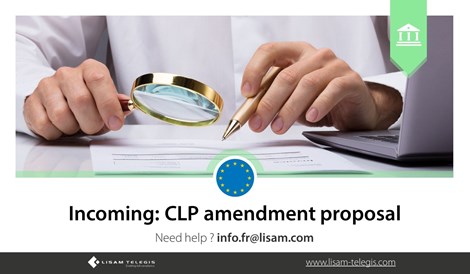Incoming: CLP amendment proposal
Incoming: CLP amendment proposal
mardi 17 janvier 2023
 On 19 December, the European Commission tabled a proposal to amend Regulation (EC) No 1272/2008 of the European Parliament and of the Council on classification, labelling and packaging of substances and mixtures. The proposed revisions of the CLP regulation are based on 3 axes:
On 19 December, the European Commission tabled a proposal to amend Regulation (EC) No 1272/2008 of the European Parliament and of the Council on classification, labelling and packaging of substances and mixtures. The proposed revisions of the CLP regulation are based on 3 axes: I. To improve the identification and classification of hazardous chemicals by introducing new definitions and scientific criteria in relation to the following properties: Endocrine disrupting ("ED"), Persistent, bioaccumulative and toxic ("PBT"), very persistent and very bioaccumulative ("vPvB"), persistent, mobile and toxic ("PMT") or very persistent and very mobile ("vPvM").
For this first set of amendments, the European Commission wants to set up the 5 measures described below:
a) Prioritise the new hazard classes mentioned above for harmonised classification. This also includes the development of prioritisation criteria to guide the submission of harmonised classification and labelling proposals.
b) Enable the European Commission to initiate and finance more harmonised classification and labelling dossiers, with the possibility of mandating the European CHemicals Agency (ECHA) or the European Food Safety Authority to develop a dossier.
c) Make available the reasons for discrepancies between the classifications notified in the ECHA inventory for the same substance.
d) Publish the names of notifiers to the inventory.
e) Update the classifications notifications to deal with the large number of obsolete classifications.
ECHA will have to publish information on the progress of proposals submitted by Member States, the Commission, manufacturers, importers or users at each stage of the harmonisation procedure for the classification and labelling of substances. For the same reason, a new obligation will be introduced for competent authorities to communicate to ECHA their decision to accept or reject a proposal for revision of a harmonised classification and labelling submitted by a manufacturer, importer or downstream user. In this case, ECHA will have to share the relevant information with the other competent authorities.
II. Improve hazard communication by making labels more understandable to users and less constraining for companies to design without obviously lowering safety levels.
For this second set of amendments, the European Commission wants to set up the 5 measures described below:
a) Introduction of new mandatory formatting rules, such as minimum font size and colour, to increase the readability of labels.
b) Establishment of specific rules on the sale of chemicals in refillable containers with the aim of reducing packaging waste (however, these rules are limited to a certain category of chemicals).
c) Introduction of a regulatory framework for voluntary digital labelling of chemicals. The Commission decided that certain information can be provided on the digital label only and will no longer be required on the packaging label. However, the information that must be included on the packaging label in accordance with the United Nations Globally Harmonised System of Classification and Labelling of Chemicals will remain on the label.
d) Expansion of the authorisation of the use of fold-out labels.
e) Introduction of additional exemptions for chemicals sold to consumers in bulk, such as fuels, and in very small packages, such as certain pens.
III. Address legal gaps and high levels of non-compliance to ensure that chemical hazard classification and communication rules are applied by all relevant actors in the supply chain.
The third and final set of amendments consists of three complementary measures described below:
a) Establishment of rules for distance sales, including online sales, which consist of an obligation for the supplier to ensure that a substance or mixture placed on the EU market through distance sales meets the requirements of the CLP Regulation.
b) Enforcement of the Digital Services Act to ensure that suppliers are able to comply with their product safety information obligations without prejudice to consumers' rights.
c) Clarification of the provisions on notifications to poison centres. All relevant actors, including distributors who place chemicals on the market across borders or rebrand or relabel mixtures, will have to ensure that they notify the relevant information to the EU poison centres.
Finally, this draft regulation is under public consultation until 02 March 2023.
